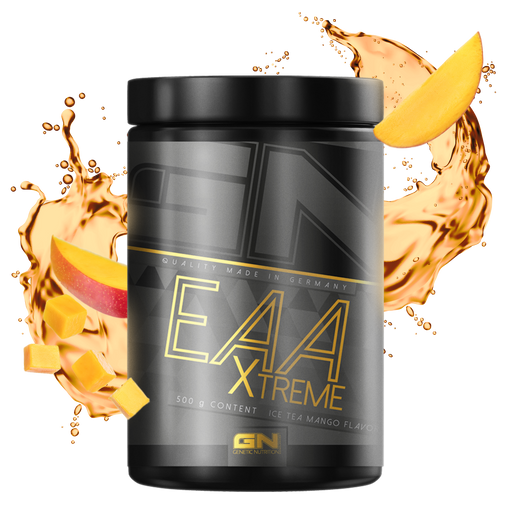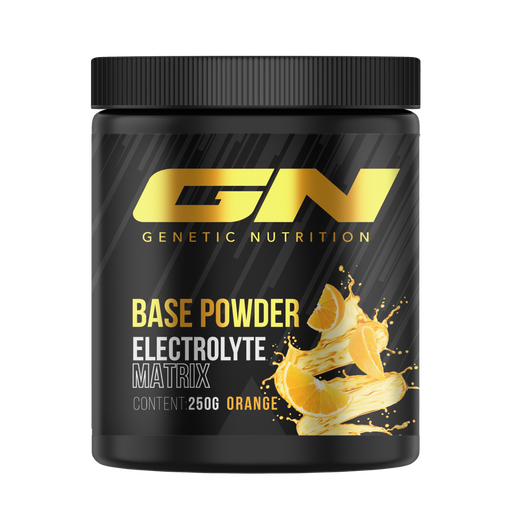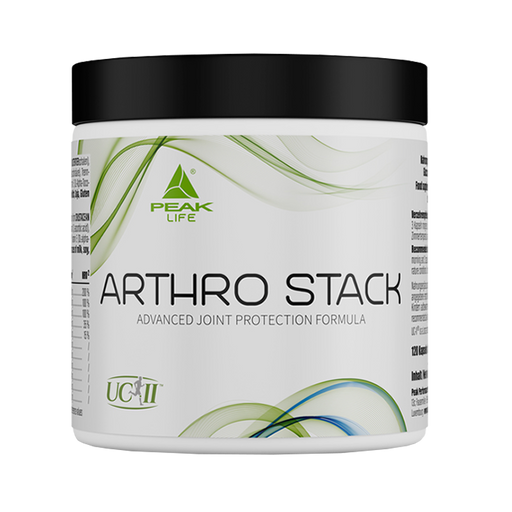Kalium
Filter
-
 Jetzt 0% sparen
Jetzt % sparen
Original-Preis €29,90 - Original-Preis €29,90Original-Preis €29,90€29,90€29,90 - €29,90Aktueller Preis €29,90|/
Jetzt 0% sparen
Jetzt % sparen
Original-Preis €29,90 - Original-Preis €29,90Original-Preis €29,90€29,90€29,90 - €29,90Aktueller Preis €29,90|/EAA Xtreme · 500g
GN Laboratories114 reviewsEin anaboles und antikataboles Kraftwerk für die Verwendung vor, während und nach dem Training oder zu jeder anderen Tageszeit, zu der Du einen Sch...
Vollständige Details anzeigenOriginal-Preis €29,90 - Original-Preis €29,90Original-Preis €29,90€29,90€29,90 - €29,90Aktueller Preis €29,90|/Jetzt 0% sparen Jetzt % sparen -
 Jetzt 0% sparen
Jetzt % sparen
Original-Preis €16,90 - Original-Preis €16,90Original-Preis €16,90€16,90€16,90 - €16,90Aktueller Preis €16,90|/
Jetzt 0% sparen
Jetzt % sparen
Original-Preis €16,90 - Original-Preis €16,90Original-Preis €16,90€16,90€16,90 - €16,90Aktueller Preis €16,90|/Base Powder · 250g
GN Laboratories24 reviewsIm menschlichen Körper gibt es einen Säure-Basen-Haushalt, gerät dieser aus dem Gleichgewicht, kann das zu einer ganzen Reihe von Symptomen stören,...
Vollständige Details anzeigenOriginal-Preis €16,90 - Original-Preis €16,90Original-Preis €16,90€16,90€16,90 - €16,90Aktueller Preis €16,90|/Jetzt 0% sparen Jetzt % sparen -
 Jetzt 0% sparen
Jetzt % sparen
Original-Preis €29,90 - Original-Preis €29,90Original-Preis €29,90€29,90€29,90 - €29,90Aktueller Preis €29,90|/
Jetzt 0% sparen
Jetzt % sparen
Original-Preis €29,90 - Original-Preis €29,90Original-Preis €29,90€29,90€29,90 - €29,90Aktueller Preis €29,90|/Bulletproof EAA's V2 · 500g
Big Zone13 reviewsVolles Spektrum an EAA´s inklusive erhöhtem BCAA Anteil 3 Gramm Leucin pro Portion Farbstofffrei Hergestellt in Deutschland Elektrolyt Matrix Adap...
Vollständige Details anzeigenOriginal-Preis €29,90 - Original-Preis €29,90Original-Preis €29,90€29,90€29,90 - €29,90Aktueller Preis €29,90|/Jetzt 0% sparen Jetzt % sparen -
 Jetzt 0% sparen
Jetzt % sparen
Original-Preis €24,90 - Original-Preis €24,90Original-Preis €24,90€24,90€24,90 - €24,90Aktueller Preis €24,90|/
Jetzt 0% sparen
Jetzt % sparen
Original-Preis €24,90 - Original-Preis €24,90Original-Preis €24,90€24,90€24,90 - €24,90Aktueller Preis €24,90|/Arthro Stack · 120 Kapseln
PEAK1 reviewFür Gelenke, Knorpel, Sehnen und Bänder – Jetzt mit verbesserter Formel Neu mit Kollagen Typ II (UC-II®) 1200 mg Glucosaminsulfat, 500 mg Chondroi...
Vollständige Details anzeigenOriginal-Preis €24,90 - Original-Preis €24,90Original-Preis €24,90€24,90€24,90 - €24,90Aktueller Preis €24,90|/Jetzt 0% sparen Jetzt % sparen
Kalium mit dem chemischen Symbol K ist ein Alkalimetall mit der Ordnungszahl 19. In reiner Form ist es silberweiß glänzend und nahezu wachsweich. An der Luft reagiert es sehr schnell zu Kaliumoxid und über einen größeren Zeitraum mit dem Kohlendioxid der Luft zu Kaliumkarbonat, was auch als Pottasche bekannt ist (K2CO3). In der Erdhülle ist es das 7. häufigste Element. Es kommt in der Natur nicht elementar vor. Die wichtigsten Kaliumverbindungen sind Kalisalze (z.B. KCl), Kalifeldspat oder der Kaliglimmer. Im Laufe der Erdgeschichte wurden die Kalisalzlager teilweise ausgeschwemmt und ins Meer gespült, daher der Anteil an Kalisalzen im Meerwasser. Kalium besitzt in der Technik nur noch eine untergeordnete Rolle. So werden Kaliumverbindungen zur Seifeherstellung, in der Glas- und Keramikindustrie oder als Trockenmittel im Labor oder in Sauerstoffgeräten verwendet. Das Element Kalium wurde im Jahr 1807 von dem englischen Chemiker Sir Humphrey Davy (1778-1829) zusammen mit dem Natrium in London entdeckt und beschrieben. Sein Name leitet sich von dem arabischen Wort Kalja = Asche ab. In der Medizin ist das Kaliumpermanganat (KMnO4) als eine spezielle Kaliumverbindung von einem gewissen Interesse. Diese Substanz wird wegen ihrer sehr starken oxidativen Wirkung zur äußerlichen Anwendung als Antiseptikum in einer Konzentration von 0,01-0,05% zur Desinfektion von Verletzungen verwendet, wird allerdings zunehmend durch andere Wirkstoffe. Eine häufigere Anwendung findet es jedoch immer noch als Desinfektionsmittelzusatz bei Spülungen und Bädern.
Funktionen im Körper
Kalium ist ein wichtiger Elektrolyt im Körper, und wird daher auch häufig routinemäßig bei Blutuntersuchungen gemessen. Dabei muss die Kaliumkonzentration im Serum zwischen 3,5 und 5,5 mmol/l betragen. Kalium ist hauptsächlich, und zwar zu rund 98%, im Zellinneren vorhanden. Kalium ist zudem an der Gewinnung von Energie und am Wasser-Elektrolyt-Haushalt beteiligt. Zusammen mit anderen Elektrolyten (geladenen Teilchen) und Molekülen ist es wesentlich an der Aufrechterhaltung des osmotischen Drucks in den Zellen beteiligt. Kalium ist unter anderem an der Aktivierung einiger Enzyme, an der Biosynthese von Eiweiß, sowie am Kohlenhydratstoffwechsel und damit an der Energieproduktion beteiligt. Zusammen mit Natrium, Kalzium und Chlor wirkt Kalium auf die Herzmuskeltätigkeit ein und ist für die Erregbarkeit von Muskel- und Nervenzellen zuständig. Das geschieht durch den Aufbau einer elektrischen Potentialdifferenz zwischen dem Zellinneren und dem Zelläußeren. Dabei ist das Zellinnere bei einer Herzzelle ca. -70 mV und das einer Muskel- und Nervenzelle ca. -90 mV gegenüber dem Zelläußeren geladen. Für besonders Interessierte ist dieser Vorgang wie folgt zu erklären: Die Zellen des Herzens besitzen, ebenso wie die Skelettmuskelzellen, eine elektrische Spannung zwischen dem Zellinneren und Zelläußeren. Beim Skelettmuskel beträgt die Spannung zwischen dem Zellinneren und der Zellaußenwand in Ruhe ca. -90 mV (mV= Millivolt), beim Herzen ca. -70 mV, wobei das Zellinnere gegenüber dem Zelläußeren negativ geladen ist. Wesentlich verantwortlich für diese Spannung ist die Eigenschaft der Zellmembran, für die verschiedenen Ionen, die sich im Körper befinden unterschiedliche Durchlässigkeiten (Permeabilität) zu besitzen. Mittels chemischer, mechanischer oder elektrischer Reize ist diese Permeabilität der Membran veränderbar. Ein Skelettmuskel behält ohne äußere Reize, z.B. durch Nervenreizung, seine elektrische Spannung dauerhaft bei. Das ist bei den Zellen des Herzens anders. Um im Herzen eine Spannung von -70 mV zu erzeugen, besteht für die Na+-Ionen zwischen Zellinnerem und Zelläußerem ein Konzentrationsunterschied von rund 10 mmol/l = 0,23 g/ zu 140mmol/l = 3,22 g/l. Weiterhin gibt es für K+ und Cl- und eine Reihe weiterer Ionen ebenfalls Konzentrationsunterschiede. So beträgt die K+-Konzentration im Zellinneren 140 mmol/l = 5,47 g/l und im Extrazellulärraum 4 mmol/l = 0,16 g/l. Im Gegensatz zur Skelettmuskelzelle ist das Ruhepotential von -70 mV bei den Herzzellen nicht stabil . Es treten geringe Mengen, vor allem Na+ in das Zellinnere ein. Dies führt zu einer Verringerung der Spannung von -70 mV im Zellinneren hin zu positiveren Werten von z.B. -60 mV. Je positiver (= geringer negativ) das Zellinnere wird, desto größer wird die Durchlässigkeit der Zellmembran für Na+ und desto positiver wiederum das Zellinnere. Ab einer Schwelle von etwa -50 mV ändert sich die Permeabilität der Zellmembran sehr schnell, so dass in kürzester Zeit relativ mehr Na+ einströmen kann. Das führt zu einer Spannungsumkehr von +30 mV gegenüber dem Zelläußerem. Während dieses Prozesses nimmt die Na+- Permeabilität dann wieder ab und die für K+ und Cl- steigt an. Es strömt K+ aus der Zelle heraus und Cl- hinein. Dies geschieht, bis der ursprüngliche Zustand wieder hergestellt, also das Zellinnere wieder eine Spannung von rund -70 mV besitzt. Es sei erwähnt, dass die extrem geringen Mengen der in die Zelle hingeströmten Na+-Ionen sowie der herausgeströmten K+-Ionen mittels so genannter aktiver Prozesse immer wieder heraus bzw. hinein transportiert werden.
Kaliumreiche Lebensmittel
Kalium kommt vor allem in Getreide, Gemüse und Früchten vor. Dabei enthalten z.B. Pfifferlinge rund 5 g Kalium pro 100 g Trockenmasse. Obst, vor allem Bananen, grünes Gemüse wie beispielsweise Spinat, Salat und Petersilie, Vollkornbrot, Fleisch und Fisch sind gute Kaliumlieferanten. So befinden sich beispielsweise in 100 g Banane etwa 400 mg (0,4g) Kalium. Es sollte aber beachtet werden, dass Kalium bei der Zubereitung von Lebensmittel durch längeres Wässern oder Kochen in Lösung geht, und damit mit dem Kochwasser verworfen wird. Im Falle von Nierenerkrankungen, bei denen der Mineralstoffhaushalt gestört ist, macht man sich diese Tatsache zu Nutze. Deshalb lässt man bei der Zubereitung für Nierenkranke Gemüse und Kartoffeln lange wässern. Bei normaler Ernährung ist in der Regel nicht mit einem Kaliummangel zu rechnen, da der erwachsene Mensch mindestens 2 g Kalium täglich aufnimmt. Ein Mangel tritt möglicherweise bei Fehl- oder Mangelernährung auf. Patienten, die unter bestimmten Herz-Kreislauf-Erkrankungen, wie z.B. Bluthochdruck leiden, benötigen etwas mehr als das doppelte der täglichen Normalmenge und sollten deshalb Ihre Ernährungsgewohnheiten mit dem behandelnden Arzt oder einer Ernährungsberatung absprechen.
Hypokaliämie, Kaliummangel
Unter einer Hypokaliämie versteht man eine Erniedrigung des Kaliums im Blutserum unter 3,5 Millimol pro Liter (mmol/l). Es ist die häufigste Form der Elektrolytstörungen. Die Ursachen für einen derartigen Kaliummangel können u.a. sein:
- Erbrechen, Durchfälle, Missbrauch von Abführmittel
- vermehrte Ausscheidung über die Nieren z.B. bei Therapie mit Diuretika
- Cushing-Syndrom
- entzündliche Darmerkrankungen
- Alkoholmissbrauch
- zu hoher Salzkonsum
- verringerte Zufuhr von Kalium, z.B. bei Ernährungsstörungen wie Bulimie oder kaliumfreien Infusionen
- akute Alkalose (Störung im Säure-Basen-Haushalt)
- Verteilungsstörungen wie bei einer Insulintherapie oder diabetischem Koma
- hohes Alter, Austrocknung durch zu geringe Flüssigkeitszufuhr
Starkes Schwitzen und körperliche Anstrengung können einen Mangel an Kalium herbeiführen. Dieser Mangel kann eine Reihe von Störungen im Körper bewirken, die relativ unspezifisch sind: beispielsweise Muskelschwäche, Müdigkeit, Kopfschmerzen, Schwindel, Übelkeit, Krämpfe und schwankende Stimmungen. Bei Kaliummangel sinkt zudem der Blutzuckerspiegel, mit der Folge der Symptome einer Unterzuckerung. Ferner können Nierenfunktionsstörungen, Herz- und Kreislaufprobleme (häufig findet man hierbei charakteristische EKG-Veränderungen) sowie Darmträgheit infolge eines herabgesetzten Muskeltonus die Folge eines Kaliummangels sein.
Hyperkaliämie, Kaliumüberschuss
Unter einer Hyperkaliämie versteht man erhöhte Kaliumwerte im Blutserum über einen Wert von 5,5 Millimol pro Liter (mmol/l). Die Ursachen für eine derartige Kaliumerhöhung können durch in eine erhöhte Zufuhr, z.B. durch Infusionen oder Bluttransfusionen zu Stande kommen. Weiterhin kann eine Hyperkaliämie entstehen, wenn Kalium vermehrt aus Körperzellen freigesetzt wird. Dieses kann bei einer Hämolyse (Untergang von roten Blutkörperchen durch Zerstörung ihrer Zellmembran), einer Azidose (Übersäuerung im Blut) sowie bei schweren Verletzungen, Verbrennungen oder Infektionen der Fall sein. Auch Nierenerkrankungen oder kaliumsparende Diuretika können zu einem erhöhten Kaliumserumspiegel führen. Besonders empfindlich für Kaliumüberdosierungen sind Dialysepatienten, bei denen der Genuss von zu viel Bananen schon ernste Folgen haben kann. Die Symptome der Hyperkaliämie gleichen, mit wenigen Ausnahmen, im Wesentlichen den bereits beschriebenen Symptomen der Hypokaliämie. Eine Ausnahme ist beispielsweise, dass es bei einer erhöhten Kaliumkonzentration nicht zur Verstopfung sondern zu Durchfall kommt.
Kaliumvergiftung
Bei einer Vergiftung mit Kalium kommt es zu einer Bradykardie, also zu einer herabgesetzten Herzfrequenz bis hin zum Herzstillstand, zu Muskelschwäche und zu Verwirrtheit. Ferner treten Sprach- und Schluckstörungen auf. Als tödliche Dosis gelten ca. 10 bis 20 g Kaliumsalze, z. B. KCL. Als Therapie kann eine Magenspülung mit physiologischer Kochsalzlösung durchgeführt werden. Ferner kommen Kationenaustauscher oder Infusionen mit Natriumhydrogencarbonat zum Einsatz. In bedrohlichen Fällen erfolgt eine Hämodialyse. Besonders wichtig ist es bei einer Kaliumvergiftung die Herzaktivitäten (EKG) zu kontrollieren und die Kaliumkonzentration im Blut zu bestimmen.
Täglicher Kaliumbedarf
Der genaue Bedarf an Kalium ist nicht eindeutig festzulegen, da er von einer Reihe von Parametern eines jeden Menschen abhängig ist. Für Menschen ab dem 17. Lebensjahr wird der Mindestbedarf als Mittelwert auf ca. zwei Gramm Kalium pro Tag geschätzt. Für Kinder und Jugendliche liegt der Bedarf laut der Deutschen Gesellschaft für Ernährung bei ein bis zwei Gramm. Säuglinge benötigen ca. 450 bis 600 mg täglich. Kalium ist in vielen Lebensmitteln enthalten. Der tägliche Bedarf gilt daher allgemein als gedeckt. Aufgrund verschiedener Bedingungen, kann aber ein Mehrbedarf an Kalium bestehen.
Bedarf im Sport
Wenn Kalium aus einer Zelle austritt, wandert Natrium in die Zelle hinein. Dabei benötigen die Zellen das Kalium für ihr Wachstum und die Synthese von Protein. Schon deshalb ist das Mineral für alle von Interesse, die ihre Muskeln aufbauen wollen.
Kalium und kohlenhydratarme Diäten
Bei Diäten, die auf Kalium-reiche Lebensmittel wie Obst und Gemüse verzichten, können Probleme mit sich bringen. Das gilt insbesondere für proteinreiche, kohlenhydratarme Diäten – bei denen man ja auf Obst und Gemüse verzichten soll. Deren Ernährungspläne führen unweigerlich zu einem hohen Säuregehalt im Körper, der während des Trainings zu Muskelschwäche führen kann und die Proteinsynthese unterdrückt. Im Laufe einer kaliumarmer Diät können auch die Nieren das Mineral nicht mehr in ausreichendem Umfang konservieren und sondern immer mehr Kalium ab. Das ist bereits dann der Fall, wenn Sie täglich weniger als ein Gramm zu sich nehmen – schon dann kann eine Hypokaliämie auftreten. Deren Symptome äußern sich in Muskelschwäche, Herzrhythmusstörungen und Glukoseintoleranz – all diese Symptome wirken sich natürlich auch negativ auf Ihre Workouts aus. Deshalb fühlen sich viele, die eine kohlenhydratarme Diät machen, oft schwach und müde – als Folge einer zu geringfügigen Kaliumzufuhr. Hinzu kommen auch noch die natürlichen diuretischen Effekte, die von der kohlenhydratarmen Diät stammen: Ein allgemeiner Wasserverlust, der sich besonders stark zu Beginn der Diät bemerkbar macht. Darüber hinaus scheidet der Körper zusammen mit dem Wasser verschiedene Mineralien aus – vor allem Natrium und Kalium.
Vorsicht bei Kalium schonende Diuretika
Bei einer Supplementierung mit pharmazeutischen Diuretika werden sämtliche Mineralien ausgeschieden, die das Wasser im Körper festhalten – insbesondere Natrium – um auch noch das letzte überflüssige Wasser unter der Haut loszuwerden. Darum nehmen auch viele Bodybuilder vor ihren Wettkampf eine hohe Dosis Kalium, weil der Verlust von Kalium, Kalzium und Magnesium zu Muskelkrämpfen führen kann und das ist das Letzte was man auf der Bühne braucht. Bei Kalium schonende Diuretika wird das Kalium (wie das Wort auch sagt) verschont. Unter normalen Bedingungen sind solche Kalium sparenden Medikamente auch kein Problem. Gefährlich wird es allerdings dann, wenn man diese Diuretika mit Kaliumsupplementen kombiniert! Es kommt zu hohe Kalziumkonzentration im Blut (Hyperkaliämie) und das kann bis zum Herztod führen, wenn das nicht rechtzeitig erkannt wird.
Dosierung
Selbst wenn der Sportler weniger Mineralstoffe im Schweiß ausscheidet als der Normalbürger, trifft dies nicht für Kalium und Magnesium zu. Ein Kaliummangel ist deshalb unter Sportler weit verbreitet. Der Bedarf liegt mindestens 3-5g am Tag zusammen mit den Mahlzeiten einnehmen. Auf jeden Fall sollte man vermeiden, ein Kaliumsupplement auf nüchternen Magen zu sich zu nehmen. Das nämlich signalisiert den Nebennieren, Aldosteron auszuschütten, das den Nieren wiederum hilft, Kalium auszuscheiden und Natrium zu behalten. Das kann zum Ödem führen, dem Austritt von Flüssigkeit aus dem Gefäßsystem. Behält der Körper im Verhältnis mehr Kalium ais Natrium bei sich, so wird dadurch die Absonderung überschüssigen Natriums unterstützt – was unter dem Strich weniger Wasser unter der Haut bedeutet.




